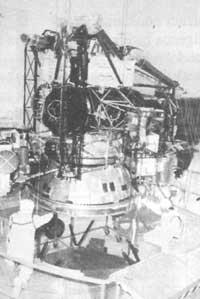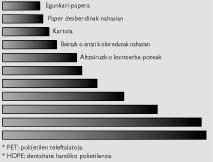Nuclear waste cannot be removed
1993/02/01 Susaeta, Tomasa Iturria: Elhuyar aldizkaria
News about nuclear waste is periodically published in the media. Recently, the Akatsu Maru loader, which transported the plutonium from France to Japan, caused a great stir, especially in France, due to the actions of the environmentalists against him. But despite not appearing in the media, the problem remains the first: in the nuclear power plants of the world hundreds of tons of radioactive waste are generated every year that nobody knows what to do. Also, many of the nuclear weapons in the hands of the military have already become garbage.
Submarine garbage
Today, more than 500 nuclear divers roam the oceans and nearly 100 nuclear ships. In addition, almost all are equipped with nuclear weapons. Have they never had an accident?
The International Atomic Energy Agency (IAEA) has conducted a study on accidents, since the military never want to clearly recognize such accidents. In the last 42 years there have been at least 31 accidents in military vehicles carrying radioactive material: aircraft, satellites, submarines, warships, etc. The exact number of nuclear weapons sunk in these accidents is not possible because the military does not want to know. Once the accident occurs, the vehicles remain in the sunken place, as it is almost impossible to leave the subsoil.
Therefore, millions of becquerel (radioactivity unit) are scattered across the seas, well above the dose of radioactivity emitted into the atmosphere by the Chernobyl accident. To this radioactive material from the accidental sea we must add the radioactive waste that several States have launched from 1946 to 1982.
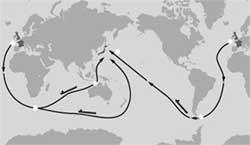
Japanese cargo ship of 4,800 tons with double hull. It has two autonomous diesel engines that allow circulating between 13 and 15 knots per hour. An anti-collision radar system has been installed that will navigate the tides of low maritime traffic. Even with the best equipment and navigation aids, the risk of accident does not disappear completely. One fact is that every year between 700-800 large cargo ships sink.
Akatsu Maru has taken about two months to tour Japan from France. On the way it crosses the typhoon zone between the Pacific tropics. The tour has remained hidden and four US satellites have constantly monitored throughout the trip. If it has not passed through Cape Horn, it would surround Cape Good Hope. The map below shows the two alternative routes, as well as the most dangerous areas.
These nuclear waste is low or medium. High, if that is true it is not so clear. Finally, in 1982 the mouth of this type of waste was banned. Meanwhile tens of thousands of barrels have been submerged. These tanks are surrounded by asphalt or cement, but seawater dissolves these coatings in 10-15 years. The United Kingdom, Switzerland, the United States, Belgium, France, the Netherlands, Korea, Japan, Sweden, New Zealand, Germany and Italy have launched over 36 years 100,000 tons of radioactive waste. Among them, the United Kingdom (76.5% of total waste), Switzerland (9.6%), the United States (7.7%) and Belgium (4.6%) have been the main causes of marine pollution.
The main landfill is the North Atlantic. The map shows that some of the radioactive cemeteries are not far from the Basque coast. Large amounts of assignments and plutoniums have been measured around it. Therefore, nuclear waste was prohibited. However, the damage is already done. In the Channel of La Mancha, on the coast of Normandy, crustaceans have a very high radioactivity rate. At 30 km, between 65 and 160 m deep, the British and Belgians launched their nuclear garbage.
On the other hand, the Norwegian government has banned fishing in an area of the North Sea near the Norwegian coast, where the radioactivity rate is dangerous. There, on April 7, 1989, a Soviet diving with missiles sank. The following explorations have shown that the nuclear diving reactor is releasing radioactivity and has reached the nuclear heads of the missiles sooner than expected by corrosion. These are examples we know. And what we do not know?
Nuclear waste through the sea
It has been said that the immersion of radioactive waste in the sea was prohibited in 1982. But the problem did not end. As we have seen, in the air, under water, in the stratosphere or above the sea, a lot of vehicles powered by nuclear energy circulates and accidents can occur anytime and anywhere. And they have happened, as has been shown in previous lines. In addition, there is a problem of vehicles that do not use nuclear energy but transport radioactive waste. In fact, today many nuclear power plants in the world produce plutonium as waste. This plutonium is recycled in places like the French plant of The Hague. But to do this, the plutonium must be carried from the nuclear power plants to the plant and accidents can occur in this way.
The concept of plutonic traffic is therefore legitimate, especially in Europe. Germany, the Netherlands, Switzerland and Belgium recycle their radioactive waste in France. Weekly, a truck loaded with plutonium oxide (IV) leaves the Hague plant in different parts of Europe. And now that the Japanese have also started recycling their waste in France, plutonium has to go through the world side by side.
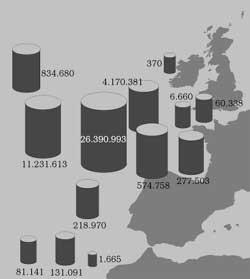
sunk for 36 years tanks containing radioactive waste on the Map. The radioactivity accumulated next to each cemetery is represented in gigabecquerelas.
Initially, plutonium to Japan was to be transported by plane through North America, but Alaska and Canada imposed a circular ban on the project. No one wants plutonium to pass over itself. Then another route was sought: The North Pole road, along the Bering Strait and the Norwegian Sea, would be transported on a Boeing 747 cargo plane, like the one that recently exploded against a home in Amsterdam. But it was impossible to meet the minimum safety requirements of the container that should be installed in the cargo room of the aircraft. At the moment containers of this type cannot be built.
Therefore, regardless of the intention of air transport, the maritime route was chosen. Is that road safe? The truth is that it is not easy to predict the risk of accident and its consequences. However, nuclear causes more terror than fear and some states have banned the transport of radioactive waste on the coasts of their territory. As a result, to travel from France to Japan, the Akatsu Maru loader has had to make one of the longest routes.
To comply with the agreement reached, this or other vessels must travel at least 3 times a year and 10 years. And this is only what corresponds to plutonium. What recycling means is well understood: waste from nuclear reactors must first be transferred to the recycling plant. Secondly, all products and waste generated by recycling itself must return to its place of origin.
While this rapid transit of radioactive waste occurs, the debate between environmentalists and nucleocrats is more than ever. But, over the years, it is increasingly leaning towards ecological balances. At present, the recycling of plutonium has no economic justification. The US, the nuclear giant, the supergenerator and the recycling program abandoned a few years ago, under Carter's presidency. France has remained practically alone on this road and has paralyzed the program of supergenerators.
Japan is building its supergenerator, but it will be very small. With the path of supergenerators almost in suspense, recycling has been orphaned (since the objective and raison d'être of the recycling plants is precisely that: taking plutonium from the waste generated in conventional nuclear power plants and using this plutonium as fuel in supergenerators). On the other hand, the cost of recycling is increasing, as increasingly demanding safety conditions must be met throughout the process.
Recycling is not a manga! How much does recycling cost? 105,000 pesetas (5,000 pounds) per kilogram. This is the current price. Suppose a 900 megawatt nuclear reactor, typical of nuclear power plants. Contains 72 tons of uranium. This fuel is slowly exhausted and every three years one third of the fuel must be renewed, 24 tons. Recycling of this fuel used 2.5 billion pesetas. (120 million pounds). But the cost doesn't end there. To the cost of recycling we must add transport and accumulation. That is, take the fuel used to the recycling plant, collect the recycled fuel and, in addition, collect and store the rest of waste generated by recycling. |
"Still life with the Sea"
The International Agency for Atomic Energy estimates that the list of accidents of the different vehicles carrying radioactive material has been the following (have all been existing but are there all those that occurred?)
- A U.S. nuclear weapon B-36 aircraft was lost at sea in the Alaska area (1950-II).
- An American aircraft with nuclear weapons was lost in the Pacific (1950-X).
- An American aircraft with nuclear weapons, B-36, was lost in the Ternua area (1953-III).
- A U.S. plane B-47, with two capsules of radioactive material, was lost in the Mediterranean (1958-III).
- A U.S. nuclear weapon B-47 aircraft was lost in the middle of the Atlantic Ocean (1958-III).
- An American F-102 fighter with a nuclear missile was lost in Haiphone Bay g (1960-V).
- During a shooting session, a US intercontinental missile fell to the sea next to Johnston Island (1962-VI).
- During a shooting session, another U.S. intercontinental missile landed by Johnston Island (1962-VI).
- American diving Thresher sinks near Cape Cod and explodes at 2,600 m depth. Its nuclear reactor had a radioactive activity of 1,147,000 gigabecquerel (1963-IV).
- The US satellite Transit 5 BN-3 fell near Madagascar. Its nuclear generator had a radioactive activity of 630,000 gigabecquerel (1964-IV).
- An American plane fell from the Ticonderoga plane and sank 5,000 meters deep in the Japanese area. He was carrying a nuclear weapon (1965 XII).
- A U.S. plane B-52 lost four atomic bombs in Spain. One fell to the Mediterranean, but it was recovered (1966-I).
- A U.S. plane B-52 lost four nuclear weapons in the frozen sea. Only part of the dispersed plutonium (1968-I) has been recovered.
- A Soviet dive with five nuclear weapons sank by the Hawaii islands (1968-IV).
- A Soviet dive with four nuclear weapons was lost in the Atlantic Ocean AI (1968).
- The American nuclear dive Scorpion sank and burst to hm of the Azores. Its nuclear reactor had a radioactive activity of 1,295,000 gigabecquerel (1968-V).
- The US nuclear satellite Nimbus B-1 fell 100 m deep in the Santa Barbara area. He was recovered (1968-V).
- A Soviet dive with nuclear weapons sank into the bay of Naples (1970-I).
- A nuclear generator of the US space mission Apollo fell south of the Fiji Islands and sank to 6,000 m deep. It had an activity of 1.650.000 gigabecquerel (1970-IV).
- A Soviet dive with four nuclear weapons was lost in the NE of the Atlantic Ocean (1970-IV).
- The nuclear-powered Japanese cargo ship Mutsu suffered a neutron leak alongside Japan due to structural failure (1974-IX).
- Soviet warship Kashin Klass, equipped with nuclear weapons, was lost in the Black Sea (1974-IX).
- An American F-14 fighter lost a Phoenix missile off the Scottish coast (1976-IX).
- The British destroyer Sheffield was sunk by the Argentine navy during the Falkland War. The British claim they did not carry nuclear weapons, but at first they said otherwise (1982-V).
- The Soviet nuclear satellite Kosmos-1402 fell to 1,600 km from the Brazilian coast. It had an activity of 1,000,000 gigabecquerel (1983-II).
- A Soviet dive with eight nuclear weapons was lost in the Kamchatka area (1983-VI).
- The French loader Mont-Louis, which transported 30 tons of uranium hexafluoride, collided with a British ferry carrying cars in the North Sea. The cargo recovered two months later (1984-VIII).
- British diving Resolution lost a Polaris missile on the Florida coast. According to the British, the missile had no nuclear head (1985-V).
- An American missile cruise was lost in the Beaufort Sea (1986-II).
- A Soviet dive with nuclear weapons sank to 5,000 m near the Bermuda islands (1986-X).
- 31 Soviet nuclear diving of Komsomolets caught fire and sank off the Norwegian coast (1989-IV).
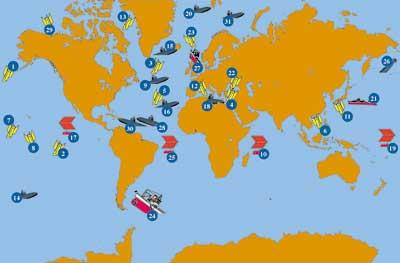
Recycling also dirty Recycling consists in the separation and recovery of the components of the fuel used. Metal bushings containing residues are sheathed and sunk in a container with boroped nitric acid. After several chemical processes, uranium and plutonium dissolve into nitrates. Then, by using an organic solvent, nitrates are separated from the rest of the fusion residues, which are mainly 90 extracts and 137, by-products of nuclear reactions. Finally, the two nitrates are separated, obtaining plutonium oxide and uranium nitrate. These two products can be reused for the manufacture of nuclear fuel. The fission remains are vitrified and accumulated in stainless steel containers. These vitrified waste must be stored within five years until “cooling”. They are then removed from the recycling plant. The rest of the waste, that is, the metal bushings containing the fuel used, are covered with concrete. The sludge generated during the process is coated with asphalt. In these concretes and asphalts are radioelements of long life, some of which will remain radioactive for hundreds of years. All of them, like the vitrified waste, will penetrate deep into the subsoil. There is a last type of waste generated by recycling: technological waste, that is, all contaminated materials and appliances used in recycling, such as tools, gloves, shoes, etc. Not all are as radioactive as the previous ones. They are covered with cement and stacked on the ground. |

Gai honi buruzko eduki gehiago
Elhuyarrek garatutako teknologia



